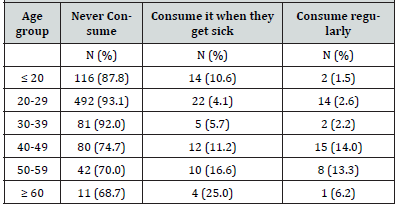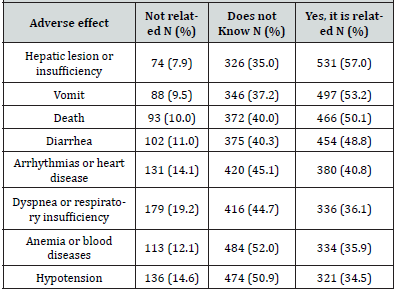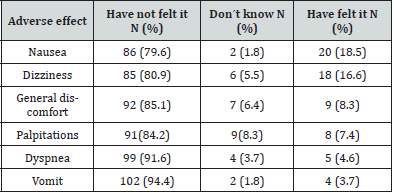Research Article 
 Creative Commons, CC-BY
Creative Commons, CC-BY
Miracle Treatments Profiting from Covid-19 Pandemic Misinformation: Chlorine Dioxide
*Corresponding author:Elena Soto Vega, PhD, School of Medicine, Anahuac Puebla University, México.
Received:November 23, 2022; Published:November 28, 2022
DOI: 10.34297/AJBSR.2022.17.002365
Abstract
During the COVID-19 pandemic, chlorine dioxide was promoted as a treatment, although health authorities worldwide had warned about the adverse effects of this compound which is a bleaching product and biocide, not recommended for human consumption. In this work, we surveyed 932 individuals, about chlorine dioxide consumption and the knowledge about its adverse effects.
We found that 11.6 % of the participants consume chlorine dioxide, of which 4.4 % do it regularly. 74.0 % of the consumers began during the COVID-19 pandemic. 59.2 % of consumers have experienced at least one adverse effect. All the participants recognize hepatic lesions as the main adverse effect. 10.2 % of the health personnel surveyed consumed Chlorine dioxide and recommended it to their patients.
To date, there is no scientific evidence or clinical trial that supports the use of chlorine dioxide as a preventive or therapeutic agent against COVID-19 or other diseases. It is important to alert the population about the fatal consequences of consuming miracle products like chlorine dioxide.
Keywords: Chlorine dioxide, COVID-19, SARS-Cov2, social media, misinformati
Introduction
Given the lack of specific preventive measures or treatment, the COVID-19 pandemic during the first global outbreak (March 2020) was characterized by misinformation. Several therapies and preventive measures appeared like miracle products, eating garlic, among others. The case of chlorine dioxide (ClO2), known as a “Miracle Mineral Solution”, promoted as a nutritional supplement to bypass the strict approval processes required by health treatments [1,2]. The sellers of ClO2 affirm that the consumption of this substance can effectively treat a huge list of pathologies including autism, cancer, Parkinson’s disease, HIV/AIDS, COVID-19, Ebola virus, diabetes among others [3-5]. ClO2, is a chemical compound used as a water purification treatment, industrial processing, and bleaching [6,7].
Chejfec-Ciociano showed that there was a significant increase in searches about ClO2 on google, particularly in Mexico during the first months of the pandemic. The ClO2 supporters said that the government measures against its use to prevent COVID-19 were a boycott by the authorities due to pharmaceutical economic interests [8,9].
The campaign to promote the beneficial effects of ClO2 was done via social media (Facebook, WhatsApp, Twitter), despite the lack of scientific evidence about the real negative effects of its consumption. There are no serious clinical trials to evaluate the safety and effectiveness of ClO2 consumption, but case reports of patients show they developed hepatic insufficiency, acute kidney injury, irritation of the gastrointestinal tract, and even death related to the use of this substance show the negative effects of ClO2 [10- 14].
The aim of this study was to determine the use of ClO2 as a treatment or for the prevention of COVID-19 and the knowledge about its adverse effects among the Mexican population.
Methods
A survey about ClO2 consumption was sent via WhatsApp, Facebook, Instagram, and Twitter among Mexican population. A cross-sectional study was conducted from August to September 2020, the first page of the e-Survey showed the purpose and informed consent, the participants needed to accept it.
The survey was divided into three sections; 1), Demographic data and general information and the last question was used to divide the participants between those who consume ClO2 and those who do not. 2)For those who had consumed ClO2 and evaluated the experienced adverse effects. 3) Evaluated the knowledge about the adverse effects of ClO2.
The statistical analysis was performed using the Graphpad website. Descriptive statistics were reported as absolute numbers. A chi-square test with Yate´s correction was performed to compare frequencies between groups. A p ≤ 0.05 was considered statistically significant.
Results
The survey was answered by 932 individuals, 792 women (85.1 %) and 139 men (14.9 %), one was excluded for a contradictory response. The mean age was 28.4 ± 11.5 years. 792 of the participants were women (85.1 %) and 139 were men (14.9 %). The analysis of the educational level showed that 51.2 % of the population had a higher education level (college (41.2 %), postgraduate degree (10.1 %)), main educational level was high school (45.4 %), college (41.2 %), postgraduate degree (10.1 %), and elementary school (0.2 %).
The most observed occupations were students (49.1 %), employee workers not related to the health sector (22.6 %), housewives (7.3 %), health workers (9.9 %), self-employees (9.6 %), and (1.5 %) unemployed. 12.5 % of the survey population found its work was related to health (doctor, nurse, student, dentist).
10.2 % of the health personnel had consumed chlorine dioxide and recommended it to their patients.
11.6 % of the108 participants accepted having consumed ClO2 (11.6 %), and of these 62 % consumed it only when they got sick, and 37.9 % consumed it regularly. 76.5 % of the participants believed in the sanitary authority’s alerts about chlorine dioxide, however, 10.6 % thought that the recommendations were performed to benefit the pharmaceutical industry and 12.9 % were not sure about their opinion. 10.2 % of the health personnel surveyed had consumed ClO2 and recommended it to their patients. The gender analysis showed that ClO2 consumption was similar between women and men. Although men believe that the authorities warn about ClO2 to protect the pharmaceutical companies (p < 0.0001).
There was a correlation between ClO2 consumption and age, showed that there was a tendency to increase chlorine dioxide its consumption with ageincreased significantly with the age, with statistical differences among those older than 40 years old compared to the younger participants (p < 0.001), and those who consumed only when they got sick (p = 0.0004) and those who consumed it regularly (p = 0.0001). (Table 1).
The ClO2 consumption increased slightly in those who had a higher education level (3.7 % elementary school and 7.4 % graduate degree) (p=0.111). The chlorine dioxide consumption was not correlated with the scholar degree, even though it increased slightly in those who had a higher education level (3.7 % elementary school and 7.4 % graduate degree) (p=0.111).
The gender analysis showed that chlorine dioxide consumption was similar between women and men. Although men the men group believe that the authorities warn about chlorine dioxide to protect the pharmaceutical companies (p < 0.0001).
74 % of the consumers declared they started consuming it because of the SARS-CoV-2 pandemic and the main source of information about ClO2 was through other people or social media, and health personnel.
11.4 % of the participants declared that ClO2 represents a safe cure for the SARS-CoV-2 infection, and 1.7 %a similar scenario was obtained declared it was a safe cure for other diseases (autism, cancer, malaria, tuberculosis, AIDS).
The knowledge of the adverse effects associated with chlorine dioxide consumption was evaluated in all of the participants. More than half of the participants recognizedm recognized hepatic lesions (57 %), vomit, and death (50.1%) as adverse effects of ClO2 consumption. (Table 2). Women recognized more adverse effects associated with ClO2 consumption compared to men (p = 0.0001). For those participants that accepted the consumption of chlorine dioxide, we asked for the presence of adverse effects (dyspnea, nausea, and vomiting among others), that had been reported in a small percentage. The most frequent adverse effects reported by the participants were nausea, dyspnea,followed by dizziness, vomiting, and palpitations. Only 3 participants referred to improvement in their disease. (Table 3).
For those participants that accepted the consumption of chlorine dioxide, we asked for the presence of adverse effects (dyspnea, nausea, and vomiting among others), that had been reported in a small percentage.
Conclusions
The misinformation about health topics in social mediainternet keeps threatensing the doctor-patient relationship, and in consequence, the health of the patient. W we found that 11.6 % of the surveyed population consumed chlorine dioxide, as a consequence of the propaganda and fake news, which was based on pseudoscience and used scientific language to look like formal treatment to the consumer. 74 % of the ClO2 consumers started during the COVID-19 pandemic
In this study, we demonstrated that COVID-19 raised the consumption of chlorine dioxide. Of the 108 participants who had consumed chlorine dioxide, 7462 % were influenced by the pandemic.
Almost all the participants recognizes the ClO2 adverse effects When we asked all the participants if they were aware of the adverse effects of chlorine dioxide consumption, we found that the most recognized adverse effect 57 % answered was hepatic lesion or hepatic lesion, and 50.1 %insufficiency (57 .0 %) followed by mentioned death, but (50.1 %), this reflects that people have the knowledge of how the chlorine dioxide affects their body but chose to consume it anyways.
74 % of the chlorine dioxide consumers began during the pandemic and even though they itwere sure that chlorine dioxide was a safe product (46.2%), 66.6 % of the consumers presented adverse effects being the most common nausea (18.5 %). 46.2 % of them were sure that chlorine dioxide cures COVID-19, and that it is effective against other diseases. It is important to consider that 66.6 % of the consumers presented adverse effects and the most common were nausea (18.5 %).
It is the patients’ responsibility to verify the certification of the health personnel in charge of them, iIt is notable that 10.2 % of the health personnel consumed or recommended itsthe consumption, this means that the source of information used by the health personnel was social networks and not scientific evidence.
However, t the success of miracle products, like ClO2 resides in the use of scientific language to explain its effects, which are based on pseudoscience, abusing of the trust or consumer ignorance of the consumer.
10.0 % of the surveyed population believe that the National and international authorities issued alerts about chlorine dioxide due to the interest of pharmaceutical companies. Many times, the propaganda of these products focuses on a global boycott with economic interests, justifying the lack of clinical evidence about this product. This situation is worrying given that if physicians prescribe chlorine dioxide, it means that their medical practice is not based on strong evidence, and is influenced by this kind of propaganda, putting at risk the health of all their patients. 10.0 % of the surveyed population believe that the National and international authorities issued alerts about ClO2 due to the interest of pharmaceutical companies.
Chlorine dioxide has no clinical trials that verify its effectiveness to treat any disease. However, sSome authors have reported their side effects such as acute kidney injury, hemolysis, myocardial damage respiratory failure, QT prolongation, dehydration, acute liver failure, low blood cell count, severe vomiting, and diarrhea [15-17]. At this point, it might seem unethical to have a clinical trial to assess its effectiveness given that its benefits have not been formally reported and the list of side effects associated with ClO2 poisoning keeps increasing.
Governments should create a strategy to warn the general population and health personnel about the use of these products. ClO2 is a corrosive substance and can produce severe injuries. T the damage to health caused by its consumption relates to the amount, concentration, pre-ingestion condition, and period of consumption. During the pandemic, some governments such as that oflike Peru that recommended ClO2 consumption.
The ingestion of all the miracle products may have severe outcomes, it is necessary to emphasize the need of warnings from health authorities, physicians, and institutions.
Limitations
The survey was shared via social media, these could compromise the population surveyed.
References
- (2019) Danger: do not drink the miracle mineral solution or similar products. US Food and Drug Administration.
- (2019) Coronavirus (COVID-19) update: FDA warns consumers about the dangerous and potentially life-threatening side effects of Miracle Mineral Solution. US Food and Drug Administration.
- Burela A, Hernández V A, Comandé D, Peralta V, Fiestas F (2020) Chlorine dioxide and chlorine derivatives for the prevention or treatment of COVID-19: a systematic review. Rev Peru Med Exp Salud Publica 37(4): 605-610.
- Elies M (2016) Dangerous chlorine dioxide as a supposed cure for cancer despite health warnings. La Vanguardia.
- https://andreaskalcker.com (reviewed February 15, 2022)
- Mordujovich BP, Marín G Dorati C (2021) Chlorine dioxide alert. Universidad Nacional De La Plata.
- (1978) Occupational health guideline for chlorine dioxide. Centers for Disease Control and Prevention.
- Chejfec Ciociano JM, Martínez Herrera JP, Parra-Guerra AD, Chejfec R, Borbosa Camacho FJ (2022) Misinformation about and interest in chlorine dioxide during the COVID-19 pandemic in Mexico identified using google trends data: Infodemiology study. JMIR Infodemiology 2(1) :e29894.
- (2020) Communique to the Population.
- (2020) Coronavirus (COVID-19) Update: FDA Warns Company Marketing Dangerous Chlorine Dioxide Products That Claim to Treat or Prevent COVID-19.
- Arellano Gutiérrez G, Aldana Zaragoza EH, Pérez Fabián A (2021) Intestinal perforation associated with ClO2ingestion: an adult chronic consumer during COVID-19 pandemic. Clin J Gastroenterol 18: 1-6.
- Arroyo C (2021) Dióxido de cloro: los efectos adversos que no se discuten. Elementos 121(suplemento COVID-19): 37-39.
- Taylor J, Wohlers D, Amata R (2004) Toxicological profile for ClO2 and chlorite. U.S. Department of health and human services.
- Aguilar Silva A, Orantes LC, Guizar Enriquez KO, Palmeros Perez FS, Basilio Jímenez A, et al. (2020) Chemical pneumonitis secondary to ClO2 consumption in a patient with severe COVID 19. Clin Case Rep Rev 6: 1-4.
- Bathina G, Yadla M, Burri S, Enganti R, Prasad R (2013) An unusual case of reversible acute kidney injury due to ClO2 poisoning. Ren Fail 35(8): 1176-1178.
- Zhao M, Wang Y (2005) One case of myocardial damage induced by ClO2 poisoning. Zhongua Lao Dong Wi Sheng Zhi Ye Bing Za Zhi 23(6): 470.
- Kishan H (2009) Chlorine dioxide-induced acute hemolysis. J Med Toxicol 5(3): 177.






 We use cookies to ensure you get the best experience on our website.
We use cookies to ensure you get the best experience on our website.